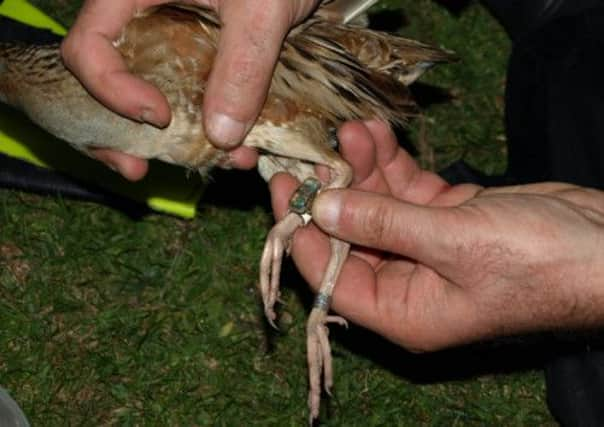Corncrakes tracked to Congo in new study


Until now, it was believed that corncrakes migrated from the tiny Hebridean island off the south-west of Scotland to the far south-eastern corner of Africa for the winter.
But scientists working with RSPB Scotland have discovered that the birds actually fly to the central African country of Congo to winter in forest clearings made by elephants.
Advertisement
Hide AdAdvertisement
Hide AdThe study is the first of its kind to capture accurate data on the birds’ route using geolocators attached to their legs which recorded their flight.
Ornithologists are using the data to spot possible links between changes in weather and farming practices in the Congo, which might explain rises and falls in numbers in breeding colonies in Scotland. Loss of habitat fuelled by increasingly intensive agriculture across Britain caused populations in Scotland to crash in the late 20th century.
A major campaign changing crofting practice helped the birds recover and numbers are now stable at around 1,200 singing males. Scientists now hope the African data will lead to further changes that will allow the bird to thrive again.
Rhys Green, the RSPB’s principle research biologist and professor of conservation science at the University of Cambridge, said: “Everything we knew about corncrakes before was based on reports from wintering grounds which were few and far between and in unusual circumstances – such as from hunters who accidentally caught them while looking for grasscutter rats to eat.
“The main areas where they were reported were in the south-east of Africa, from around Zambia down to the north of South Africa, which is where corncrakes from Russia migrate to and, therefore, people thought that the wintering grounds for Scottish corncrakes were mainly there as well.
“This study shows that we were wrong. They are actually doing this double migration, flying to western Africa first and then on to the western part of the Congo basin.
“There are lots of forests there and they don’t like forests so they will be in open areas, like those cleared by forest elephants, raising the intriguing possibility that Scottish corncrakes are lurking around in the long grasses between elephants legs.” He added: “Now that we know where they are, we can analyse the data on weather, like changing rainfall or overgrazing in the Congo, to see whether there is any correlation with changes in breeding populations back on Coll.”
The geolocator project began when 50 adult male corncrakes were captured in and around the RSPB’s nature reserve on Coll in June 2011. Fitting the devices was carried out by playing a recording of the bird’s distinctive, rasping call at night and attracting males, fooled into thinking a rival was in their territory, to “blunder” into a net.
Advertisement
Hide AdAdvertisement
Hide AdLast May, researchers returned to Coll and retrieved five geolocators, which experts said was a good result given the difficulties in recapturing the birds. Green added: “These five birds all left Africa within the same three weeks, so we can now look at the data to see if bird A left before bird B because the area it was in was getting less green sooner. This will be really useful information for conservation.”
An RSPB Scotland spokeswoman said: “Knowing more about the movements of this elusive migratory species will play a key part in future conservation, allowing us to monitor potential threats from issues … whilst we continue to support the breeding population here in Scotland with well-funded agri-environment schemes.”
The government-funded schemes were set up after research by the RSPB showed that changes in the timing and methods of mowing of hay and silage, combined with the establishment of safe havens of unmowed habitat to shelter the birds in spring and autumn, could reverse the corncrakes’ fortunes. Financial support to farmers and crofters to make the necessary on-the-ground changes was then rolled out across large parts of the Scottish islands.
Twitter: @ScotsmanJulia